I've been working on software engineering for six years as a Java developer. I am committed to writing code that is of the highest caliber and distinguished by its effectiveness .
Don't wanna be here? Send us removal request.
Text
"Cracking the Literal Language: Understanding the Types and Significance of Literals"
Literals, which are also referred to as constants in Java, represent data items with values that remain fixed or unchanging. These can include various types of values such as numeric, character, boolean, or String values. These literals are capable of being assigned to any of the 8 primitive data types in Java.
Types of Java Literals
Java supports five types of literals, namely:
Integer literals
Floating literals
Boolean literals
Character literals
String literals
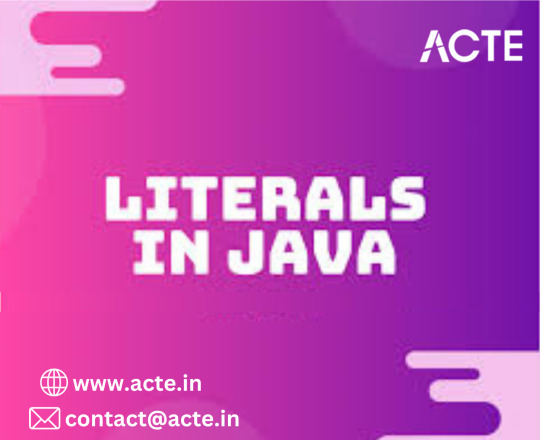
Integer literals:
Java Integer Literals represent whole numbers without any fractional or exponential part. They can be positive, negative, or without a sign. The rule for writing integer literals specifies the presence of at least one digit and the absence of a decimal point. An integer literal can contain positive (+) or negative (-) signs, and if no sign is provided, the number is considered positive. Commas should not be used in an integer literal.
Integer Literals are classified into three categories:
Decimal Integer Literals:
A decimal integer literal contains digits from 0 to 9, with the sequence being considered a decimal integer literal unless it starts with 0. For instance, 1256, 67, +98, -54 are valid decimal integer literals, while 0987 is not.
Octal Integer Literals:
Octal integer literals contain digits from 0 to 7, always starting with 0. For example, the decimal integer 8 is written as 010 in octal form, and 49 in decimal can be represented as 061 in octal. When writing octal literals, they must start with 0 and exclude 8 or 9, which are invalid octal digits.
Hexadecimal Integer Literals:
A hexadecimal integer literal starts with 0x or 0X, and it can contain digits from 0 to 9 and alphabet characters from A to F. Both uppercase and lowercase letters can be used, except those other than A to F, which are not allowed. For example, the decimal integer 12 can be written as 0XC in hexadecimal form.
Floating literals in Java:
Floating literals, also known as real literals, include fractional parts and decimal points. They can be expressed in two forms: either in fractional form or in exponential form. It is important to note that floating literals cannot be specified in octal or hexadecimal values; they must be in decimal form with a decimal point (.) separating the digits. The rule for writing a floating literal is as follows:
It should be in fractional form, with at least one digit before the decimal point and at least one digit after the decimal point.
A floating literal can have a positive (+) or negative (-) sign preceding it. If no sign is provided, the floating literal is considered to be positive.

Boolean Literals in Java:
Boolean literals in Java are limited to two values: true and false. These values are utilized for assigning flag variables and checking conditions. Any other values are not accepted as valid boolean literals, and the boolean data type must be used when working with Boolean literals.
Example:
boolean b1 = true; // valid boolean value
boolean b2 = false; // valid boolean value
boolean b3 = 5; // invalid boolean value
Java Character literals: Character literals in Java are single characters enclosed within single quotes (' '), such as 'Z'. To represent a character literal, the char data type is utilized, and it must contain a single character enclosed within single quotes.
For example,
char ch = 'A';
Additionally, in Java, specific non-graphic characters can be denoted as character literals. Nongraphic characters are those that cannot be directly entered from the keyboard, like backspaces, tabs, etc. These nongraphic characters can be indicated as escape sequences.
Java String Literals: Java String Literals signify sequences of characters enclosed within double quotes (" "). They can encompass zero or more characters and may contain escape sequences. It is worth noting that all String-Literals belong to the String class.
For example, some valid string literals include:
String s = "Abc"
String s = "TechVidvan"
String s = "I love my country"
String s = "Rita's book" // \’ is an escape sequence
String s = "\ab" // \a is an escape sequence
The learning journey with ACTE Technologies is transformative, providing you with the knowledge and skills essential for success in the ever-evolving realm of software development. Whether you're seeking to launch a new career or enhance your current skill set, comprehensive Java Course at ACTE Technologies' equips you to confidently tackle real-world coding challenges and unlock promising career opportunities. Upon completion of the Java training, you'll be well-prepared to embark on a rewarding career as a Java developer, making a significant impact in the technology industry and beyond.
0 notes
Text
"Exploring the Depths of Java's OOP : A Practical Journey"
Object-Oriented Programming (OOP) in Java is a programming paradigm where programmers define both the data type and the operations that can be performed on the data. Java's prominence in the industry underscores the crucial role of OOP principles. In the Java context, building an object-based application involves class declaration, object instantiation, and fostering interactions between these objects.

The Four Basic Principles of OOP Are Follows:
1. Inheritance
2. Encapsulation
3. Abstraction
4. Polymorphism
1. Inheritance:
Comprehending these principles is essential for mastering the craft of object-oriented programming and serves as the cornerstone for constructing resilient and effective Java applications.
Object-Oriented Programming (OOP) encompasses the notion of inheritance, where one class can inherit the attributes and behaviors of another, facilitating code reuse and establishing connections between distinct classes. Inheritance facilitates the creation of a hierarchical structure among classes in the program. Let’s examine the various forms of inheritance.
· Single Inheritance:
• In single inheritance, a class inherits the attributes of another, enabling the derived class to reuse the characteristics and behaviors of the parent class.
• This encourages the reuse of code and the extension of existing code.
· Multilevel Inheritance:
• Multilevel inheritance occurs when a class is derived from a class that is itself derived from another class.
• In this scenario, the derived class inherits the attributes and behaviors of all its predecessor classes, establishing a hierarchical relationship among the classes.
· Hierarchical Inheritance:
• Hierarchical inheritance transpires when a class has multiple child classes, all of which share the same parent class.
• This form of inheritance permits multiple subclasses to inherit common attributes and behaviors from a single parent class.
· Hybrid Inheritance:
• Hybrid inheritance amalgamates multiple inheritance and multilevel inheritance.
• Given that multiple inheritance can lead to ambiguity and is not supported in Java, hybrid inheritance is accomplished through the use of interfaces.
• This form of inheritance enables a class to inherit attributes from multiple interfaces.
· Grasping these types of inheritance is pivotal in the development of Java applications, as it fosters effective code organization and encourages the efficient utilization of resources. Next, we will delve into another essential OOP concept in Java, namely encapsulation.
2. Encapsulation
Encapsulation, a core concept in Object-Oriented Programming (OOP), acts as a mechanism that combines data and code into a unified entity. Its primary function is to shield data from unauthorized alterations. To comprehend this concept better, envision a medical capsule where the drug remains enclosed within the encapsulation. Similarly, in OOP, encapsulation ensures that the methods and variables of a class remain hidden and protected.
In Java, we can achieve encapsulation by,
• Declaring the class variables as private.
• Offering public setter and getter methods to enable the modification and retrieval of variable values.

3. Abstraction
Abstraction in Object-Oriented Programming (OOP) involves the management of concepts rather than events. It revolves around concealing intricate details and exposing only the fundamental aspects to the user. Imagine the scenario of receiving a call on a mobile phone, where the user is presented with the options to either accept or decline the call. Despite this simplified interface, numerous complex processes take place behind the scenes. Abstraction effectively simplifies complexities by concealing unnecessary details from the user. Abstraction can be achieved in two ways.
a) Abstract Class:
• An abstract class in Java is identified by the ‘abstract’ keyword. It cannot be instantiated, indicating that you cannot create an object of an abstract class.
• An abstract class can include both abstract and concrete methods.
• This allows for different levels of abstraction, ranging from 0% to 100%, depending on the usage of abstract methods.
b) Interface:
• An interface in Java serves as a blueprint for a class, representing a collection of abstract methods and static constants.
• All the methods within an interface are public and abstract, with no constructor.
• Interfaces facilitate 100% abstraction and also permit the implementation of multiple inheritances in Java.
• Implementing an interface ensures that a class strictly adheres to the behavior promised by the interface.
• It guarantees that specific functionalities remain consistently present across multiple subclasses, even though the implementation of these functionalities may differ.
• This flexibility enables the creation of various subclasses, such as those representing different car brands, each implementing the same ‘ParentCar’ interface with distinct functionalities.
4. Polymorphism
Polymorphism, which means having many forms, is the ability of something, like a variable, function, or object, to take on different forms.
To explain this, let’s look at cricket. In cricket, there are different kinds of bowlers, like fast bowlers, medium pacers, and spinners. They all have their own way of bowling. For example, a fast bowler bowls differently from a medium pacer or a spinner. They each have their unique style and technique, even though they all do the same thing, which is bowling.There are two types of polymorphism in Java.
Runtime polymorphism:
· In this type, the call to an overridden method is determined at runtime rather than during the compilation phase.
· It allows a reference variable to invoke an overridden method of a superclass at runtime. Method overriding exemplifies runtime polymorphism.
Compile-time polymorphism:
· This type involves resolving a call to an overloaded method during the compilation phase rather than at runtime.
· Method overloading represents an instance of compile-time polymorphism. It permits a class to contain multiple methods with the same name but different arguments.
· Understanding these different aspects of polymorphism is crucial for constructing adaptable and resilient Java applications.
· By comprehending these OOP concepts, developers can create secure, reusable, and simplified Java applications.
Advantages of Object Oriented Programming:
1. Enhanced efficiency in software development
2. Increased software maintainability
3. Accelerated development cycles
4. Reduced development costs
5. Elevated software quality
By the end of my Java training at ACTE Technologies, I felt confident in my Java skills and was well-prepared to tackle Java-related projects in real-world scenarios. The comprehensive curriculum, expert trainers, practical approach, and collaborative learning environment made my experience at ACTE Technologies invaluable in becoming proficient in Java programming.
0 notes
Text
"Understanding How Java Code Gets Compiles: A Comprehensive Guide"
The process of compiling Java involves converting the source code into an intermediate binary form known as Bytecode. This Bytecode acts as an intermediary representation that cannot be executed directly by the machine, necessitating the use of the Java Virtual Machine (JVM) for interpretation and execution.
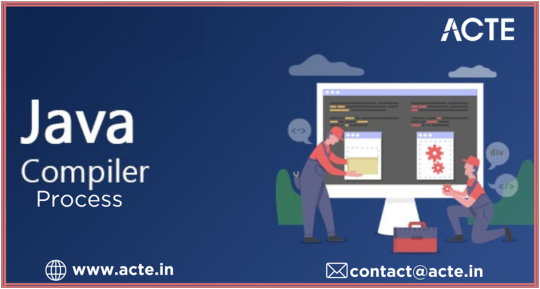
The Java Virtual Machine (JVM) functions as a platform for executing Java programs. It integrates a Java interpreter that understands Bytecode and translates it into machine code suitable for the underlying computer's execution. It's important to recognize that each platform has its own JVM, customized for the particular operating system it operates on. This tailored approach guarantees the consistent execution of Java applications across diverse platforms, upholding Java's "write once, run anywhere" philosophy. Below is an outline of the fundamental structure detailing how your computer runs Java programs.

Java Source Code:
• The Java source code, identified by the .java extension, consists of human-readable instructions crafted in the Java programming language.
• Developers create and draft the source code, establishing the logic and operations of the Java program.
• It acts as the primary input, laying the groundwork for the subsequent compilation phases.
Java Compiler:
• The Java compiler, activated by the javac command, converts the human-readable .java file into a .class file containing Java bytecode.
• During this process, the compiler scrutinizes the code syntax and structure, ensuring accuracy and identifying potential errors.
• The compilation procedure also encompasses code optimization for improved performance and efficiency during execution.
Java Bytecode:
• The .class file produced by the compiler contains Java bytecode, serving as a low-level representation of the original source code.
• This bytecode cannot be directly executed by the machine but functions as an intermediate form that can be understood and executed by the Java Virtual Machine (JVM).
• It facilitates platform independence, enabling the same bytecode to operate on any system equipped with a compatible JVM.
Java Virtual Machine (JVM):
The Java Virtual Machine (JVM) is a software platform that provides a runtime environment for executing Java code and other programming languages tailored to the JVM. Noteworthy features of the JVM include:
• Operating as a runtime environment for Java and other JVM-compatible languages.
• Managing the interpretation and execution of compiled Java bytecode, derived from the original Java source code.
• Offering crucial functionalities such as memory management, security mechanisms, and cross-platform adaptability.
• Empowering developers to write code in Java or other compatible languages, ensuring seamless execution across various platforms with a JVM installed.
• Supporting an array of popular JVM languages, including Java, Kotlin, Scala, and Groovy. Finding extensive application in diverse sectors, such as enterprise software development, web development, and mobile app development.
.jar File:
• The .jar (Java Archive) file acts as an archive for bundling multiple Java classes and resources into a single file.
• It simplifies the distribution and sharing of Java applications, facilitating the smooth transfer of entire Java programs or libraries.
• The .jar file contains the essential components for executing the Java program, providing a convenient means to package and transport Java applications.
Understanding each stage of the compilation process, from the human-readable Java source code to the program's execution within the JVM, is crucial for developing a comprehensive understanding of the basics of Java development and execution.
Responsible tasks for Compiler:
In addition to compiling a source program, the Java compiler performs the following tasks:
a) The Java compiler verifies the program for syntax errors, generating a comprehensive list of error messages upon encountering any issues. It refrains from producing an object code until the reported errors are rectified.
b) With the assistance of the Java Virtual Machine (JVM), it transforms the source code into bytecode.
c) If necessary, it appends supplementary code to the program during the compilation process.
If you are seeking to enhance your grasp of Java, you may find it beneficial to explore the comprehensive Java learning programs provided by ACTE Technologies. Achieving proficiency in Java necessitates a combination of persistence, commitment, and consistent practice. It is crucial to remain dedicated to improving your skills over time. ACTE Technologies' Java learning program offers certifications and assistance with job placement. With sustained effort, you can master Java and utilize its capabilities to develop a wide range of applications and projects.
0 notes
Text
“Understanding Compiler Variants: An In-Depth Analysis of Various Compiler Types”
Java depends on dedicated programs to convert human-readable code into machine-understandable language. This transformation results in bytecode, a series of 0s and 1s that computers can interpret. The widely acknowledged primary Java compiler, javac, is particularly familiar to newcomers in the field. With the aid of these compilers, we can run Java programs on a variety of platforms, including Windows, Linux, and macOS. While there is flexibility in selecting a compiler, having knowledge about the availability of different compiler options can be advantageous.

Java Compiler:
• Compilers act as an intermediary between human-readable language and machine-interpretable code.
• When dealing with Java, the compiler processes the .java file, converting each class into a matching .class file that remains independent of any particular Operating System.
• As a result, Java is recognized as a platform-agnostic language. The javac compiler is tasked with converting our Java code into machine language, which is commonly referred to as bytecode.
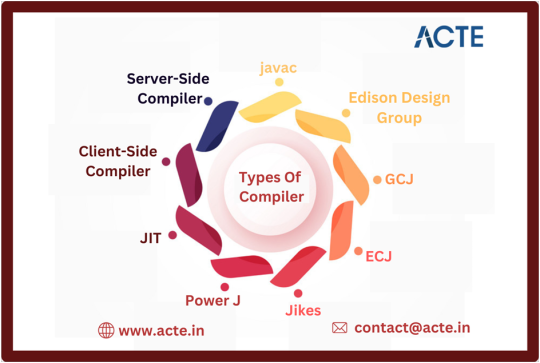
1. Javac:
· Javac stands as the standard Java compiler, primarily serving the purpose of translating Java source code into bytecode.
· It plays a pivotal role in the Java development process, enabling the execution of Java programs across various platforms.
· Javac commonly integrates with popular Integrated Development Environments (IDEs) such as Eclipse and IntelliJ IDEA.
2. Edison Design Group:
· The Edison Design Group (EDG) compiler is renowned for its preprocessing and parsing capabilities.
· It aids in optimizing code and enhancing overall software performance.
· Although it may not be as extensively integrated into IDEs as Javac, it remains a valuable tool for specific tasks related to code refinement and enhancement.
3. GCJ:
· The GNU Compiler for Java (GCJ) is a versatile compiler that not only handles Java source code but also supports other programming languages like C, C++, Fortran, and Pascal.
· While its support is confined to UNIX, GCJ serves as a useful option for developers seeking a free and multi-purpose compiler for their projects.
4. ECJ:
· The Eclipse Compiler for Java (ECJ) is seamlessly integrated with the Eclipse IDE, providing developers with a comprehensive environment for Java development.
· ECJ stands out for its distinctive approach to identifying and managing compile-time errors, allowing for quicker debugging and development cycles within the Eclipse IDE.
5. Jikes:
· Jikes, an open-source Java compiler developed at IBM, is renowned for its high-performance capabilities, especially in managing extensive projects.
· However, it lacks support for newer Java versions, making it more suitable for legacy systems operating on older versions of the Java Development Kit (JDK).
6. Power J:
· Power J is a compiler created at Sybase, now under the ownership of SAP.
· Tailored for the Windows platform, it provides developers with an efficient means to compile and execute Java code within specific development environments.
7. JIT:
· The Just-In-Time (JIT) compiler constitutes an integral component of the Java Runtime Environment (JRE), responsible for optimizing Java application performance during runtime.
· It dynamically compiles segments of bytecode into native machine code, resulting in improved execution speed and overall performance.
8. Client-Side Compilers:
· The client-side compiler (C1) concentrates on reducing the startup time of applications operating under limited resources.
· By specifically optimizing the code for client-side environments, this compiler ensures that Java applications can launch swiftly and operate efficiently, even on systems with restricted capabilities.
9. Server-Side Java Compilers:
· Server-side compilers (C2) are specifically engineered for enterprise-level applications, offering advanced optimization techniques and algorithms to enhance the performance of Java applications operating within server environments.
· These compilers facilitate the execution of intricate operations and ensure that server-side applications can effectively manage substantial workloads.
If you are looking to bolster your Java expertise, you can take advantage of the comprehensive Java learning programs offered by ACTE Technologies. Achieving mastery in Java demands consistent dedication to learning, regular practice, and unwavering commitment. ACTE Technologies provides an array of Java learning courses, complete with certifications and support for job placements, enabling you to acquire proficiency in Java. By maintaining a persistent learning routine, you can develop a strong grasp of Java and leverage its capabilities to create a wide range of applications and projects. Should you have any more questions or require further discussion on related topics, please feel free to get in touch. Your interest and support are greatly valued and inspire me to share additional valuable insights on Java.
0 notes
Text
"Understanding Java Tokens: A Comprehensive Guide"
The Java programming language relies on classes and methods as the backbone of program structure. Methods, in particular, incorporate expressions and statements essential for carrying out specific operations. These statements and expressions are constructed using tokens, which serve as the fundamental building blocks. Tokens represent key elements that hold significance for the Java compiler. They encompass variables, constants, and operators, all of which are vital for the proper execution of a Java program. This section will provide a detailed exploration of the concept of tokens in Java, shedding light on their significance and role within the language.
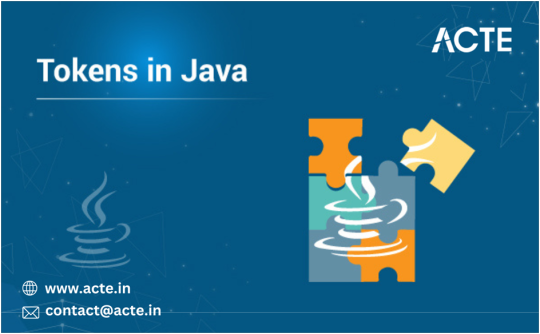
Java tokens are the individual text components that the Java compiler divides lines of code into. These components, which are the smallest entities in a Java program, are recognized by the compiler. Delimiters play a key role in separating these tokens and assisting the compiler in identifying errors. It should be noted that the delimiters themselves are not classified as Java tokens. The Java compiler converts these tokens into Java bytecode, which is subsequently executed within the interpreted Java environment.
Types of Tokens
Java token includes the following
Keywords
Identifiers
Literals
Operators
Separators
Comments
Keywords:
Keywords in Java are predetermined terms that are reserved and cannot be utilized for naming classes, functions, or variables. These words are essential elements within the syntax and structure of the Java language, overseeing diverse functionalities such as data type definitions, control flow, and object-oriented programming. Examples of Java keywords encompass "public," "static," "void," "if," "else," "for," "while," and "class," among others. These keywords are pivotal in facilitating the generation and operation of Java programs.
Identifiers
• User-defined names, called identifiers, are employed to represent variables, constants, functions, classes, and arrays in Java. These identifiers generally consist of letters, underscores, or dollar signs as the initial character. In the context of the goto statement, a label operates as a specific type of identifier. Ensuring that the identifier name doesn't clash with reserved keywords is imperative. The rules for declaring identifiers are as follows:
• The initial character of an identifier must be a letter, underscore, or dollar sign. It cannot commence with a digit, although it can include digits.
• Identifiers cannot incorporate whitespace.
• Identifiers are case-sensitive.
Literals:
In programming, a literal represents a particular notation used to denote a constant or fixed value within the source code. It can manifest as an integer literal, string literal, Boolean literal, and more. Once established by the programmer, its value remains unchanging throughout the program. Java comprises five primary types of literals:
Integer
Floating Point
Character
String
Boolean
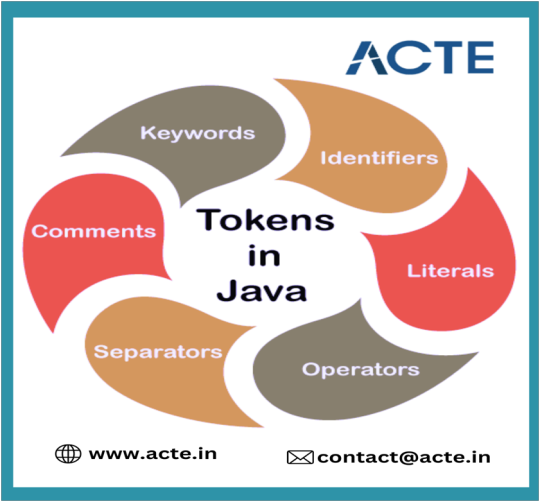
Operators:
In programming, operators are special symbols that instruct the compiler to carry out specific operations. Java encompasses various types of operators that can be classified based on the functionalities they offer. The eight types of operators in Java are as follows:
1. Arithmetic Operators(+ , - , / , * , %)
2. Assignment Operators(= , += , -= , *= , /= , %= , ^=)
3. Relational Operators(==, != , < , >, <= , >=)
4. Unary Operators(++ , - - , !)
5. Logical Operators(&& , ||)
6. Ternary Operators((Condition) ? (Statement1) : (Statement2);)
7. Bitwise Operators(& , | , ^ , ~)
8. Shift Operators(<< , >> , >>>)
Separators:
Separators in Java, also known as punctuators, establish the structure and syntax of the code. Java consists of nine separators, which are as follows:
Square Brackets []: These are utilized for defining array elements. One pair of square brackets denotes a one-dimensional array, while two pairs signify a two-dimensional array.
Parentheses (): They are employed for invoking functions and parsing parameters.
Curly Braces {}: These mark the beginning and end of a code block.
Comma (,): It separates two values, statements, or parameters.
Assignment Operator (=): This symbol assigns a value to a variable or a constant.
Semicolon (;): Typically found at the end of statements, it separates two statements.
Period (.): It separates the package name from the sub-packages and the class. Additionally, it separates a variable or method from a reference variable.
Comments:
Java comments are crucial for providing contextual information within the code. While Java recognizes these comments as tokens, it doesn't process them further and treats them as whitespace. There are two main types of comments supported in Java:
Line-Oriented: These comments begin with a pair of forward slashes (//) and extend until the end of the line. They are utilized for single-line comments.
Block-Oriented: These comments start with /* and continue until closed with */. They can span multiple lines and are employed for multi-line comments or comment blocks.
In conclusion, enrolling in Java training at ACTE Technologies can significantly boost your career advancement and skill development. Whether you aim to become a Java developer, specialize in web application development, or enhance your programming proficiency, the comprehensive Java training program at ACTE Technologies provides a strong foundation and a supportive environment for excelling in the rapidly evolving field of software development. Whether you are just starting your journey in software development or looking to enhance your existing skills, the well-structured and impactful Java training at ACTE Technologies offers a clear path to success in the ever-changing world of technology.
0 notes
Text
“Becoming Proficient in Java Methods: An In-Depth Guide for Developers”
A Java method is a set of logical Java statements designed to accomplish a specific task, providing a way to reuse code without unnecessary repetitions. Unlike Python, C, and C++, in Java, each method must be part of a distinct class. Methods cannot exist independently but are instead an essential part of a Java class. To simplify, imagine a scenario where a particular task is performed frequently within a program. You have two options for addressing this in your code:
1. Repetition: You can rewrite the same code for the task multiple times throughout the program.
2. Method: Alternatively, you can encapsulate the common logic in a method and simply call that method whenever the task needs to be performed.

Components for Creating Java Methods
A method has mainly 5 components. These components are required to declare a method in a Java program. They are:
1. Access Specifier
2. Return Data Type
3. Name of the Method
4. Arguments
5. Body of the Method
1. Access Specifier:
· In Java, access specifiers control the accessibility of classes, methods, and other members within a program. The following are the four commonly used access modifiers in Java:
· Public: Methods declared as public are accessible from all classes within an application, regardless of their location. This access modifier provides the highest level of accessibility.
· Protected: Methods declared as protected are accessible from the class within which they are defined and all subclasses of that class. Additionally, these methods can be accessed from other classes in the same package.
· Private: Methods declared as private are only accessible from the class within which they are defined. They cannot be accessed from any other class, including subclasses or classes in the same package.
· Default (Package-private): Methods declared with default access, also known as package-private, are accessible from the class within which they are defined and from other classes declared within the same package as the class enclosing the method. This access modifier provides access within a specific package but restricts access from external packages.
2. Return Data Type In Java, the return data type of a method defines the kind of data that will be returned when the method is executed. If a method doesn’t return any value, it is declared with the return type ‘void’. For example, if a method named ‘calculateAverage’ has a return type of ‘float’, it implies that this method will compute the average of a set of numbers and provide the result in the form of a floating-point value.
Here are some commonly used return types in Java:
· void: Signifies that the method does not return any value.
· int: Indicates that the method will return an integer value.
· float: Specifies that the method will return a floating-point value.
· double: Denotes that the method will return a double-precision floating-point value.
· boolean: Specifies that the method will return a boolean value, which can be either true or false.
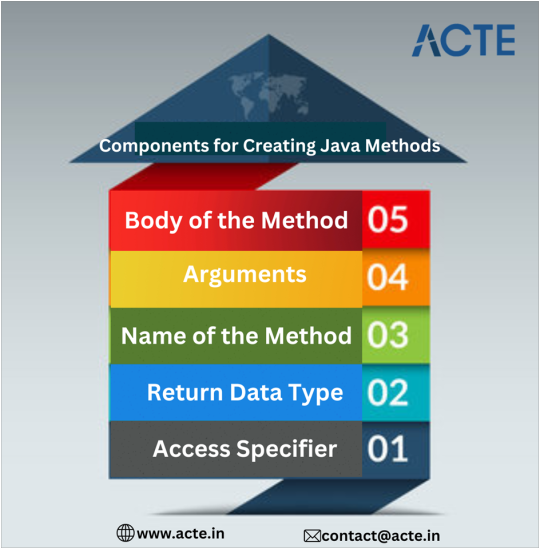
3. Name of the Method
· In Java, the method name functions as the identifier used to execute the method and carry out a specific task.
· Typically, the name assigned to a method is chosen to mirror the intended functionality it is designed to perform.
· This approach ensures that the purpose of the method is easily comprehensible and memorable, thereby facilitating efficient usage and maintenance of the codebase.
· By opting for descriptive and intuitive method names, you can enhance the readability and comprehensibility of your code, simplifying the understanding of the intended functionality for both yourself and other developers.
· Clear and meaningful method names contribute significantly to the overall maintainability and resilience of your Java application, fostering smoother collaboration and efficient problem-solving within your development team.
4. Arguments • In Java, arguments are the inputs provided to a method, and their presence can vary depending on the specific implementation.
• If a method does not require any input, it does not need to have any arguments specified in its signature.
• However, if a method needs specific inputs to perform its intended task, these inputs can be declared as arguments in the method signature.
• When calling a method with arguments, you must provide the required inputs as per the method’s signature.
• Failure to supply the necessary arguments will lead to a compilation error, as the method won’t be able to execute without the required input parameters.
• By effectively incorporating arguments, you can create dynamic and versatile methods capable of performing various tasks based on the specific inputs provided during their invocation.
• Understanding how to handle method arguments is crucial for developing flexible and adaptable Java programs that can accommodate diverse computational requirements.
5. Body of the Method
• The body of a method in Java refers to the section of code where all the statements and programming logic of the method are enclosed. When the method is called, the statements within the method’s body are executed, allowing the method to perform its intended task or computation.
• Typically, the method body consists of a sequence of Java statements, including variable declarations, control structures (such as if-else statements and loops), method calls, and other relevant programming constructs.
• These statements collectively define the functionality of the method and specify the operations that the method will perform when invoked.
• By meticulously designing and implementing the body of a method, you can develop efficient and effective Java programs capable of seamlessly carrying out specific tasks and computations.
• Well-structured method bodies significantly contribute to the readability, maintainability, and overall performance of your Java codebase, thereby facilitating a smoother development process and enhancing the functionality of your applications.
Types of Methods in Java
In Java, there are two primary types of methods:
Predefined Methods:
• Predefined methods, also referred to as built-in or standard library methods, come predefined within the Java compiler.
• These methods are pre-tested and readily usable in any Java program. Java provides an extensive range of predefined methods for tasks like string manipulation, mathematical operations, input/output functionalities, and more.
• These methods are an indispensable component of the Java programming language and its standard libraries.
User-defined Methods:
• User-defined methods are methods created by developers to perform specific functions within a Java program.
• These methods are tailored by developers to execute custom operations or tasks according to their application requirements.
• Thorough testing by the developer is essential to ensure the accuracy and reliability of user-defined methods. Creating user-defined methods allows developers to encapsulate specific functionalities, promote code reusability, and improve the overall organization and maintainability of their Java programs.
• Understanding the difference between predefined and user-defined methods is crucial for harnessing the full potential of the Java programming language and building robust and efficient applications.
• By effectively combining both predefined and user-defined methods, developers can streamline the development process and create comprehensive and powerful Java applications.
Upon completion of my Java training at ACTE Technologies, I gained a strong sense of confidence in my Java skills and felt well-equipped to take on Java-related projects in real-world settings. The all-encompassing curriculum, skilled trainers, hands-on approach, and collaborative learning atmosphere made my time at ACTE Technologies invaluable in honing my proficiency in Java programming.
0 notes
Text
“Understanding the Essence of Variables in Java Programming”
In Java programming, variables act as essential components, enabling the storage and manipulation of data within applications. They can be categorized into different types, including local, instance, and static, and are instrumental in managing data across various scopes. Grasping their differences and functionalities is vital for successful Java programming, laying the foundation for the creation of resilient and high-performing applications.
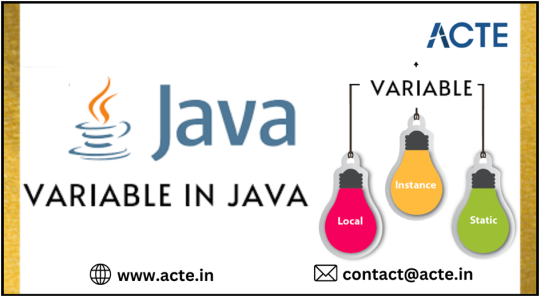
Variable In Java:
Variables function as containers for storing data, where each variable is assigned a specific data type defining the kind of data it can accommodate. Essentially, a variable can be compared to a label attached to a memory block containing data, or it can be viewed as a name assigned to a specific memory location. Notably, the value within a variable is subject to modification at any point during program execution.
Memory Blocks and Variables in java
Grasping the concept of memory blocks and variables is fundamental in understanding programming.
In Java, the system's memory is divided into segments known as data blocks.
When a variable is initiated, a designated portion of the memory block is reserved and linked to the variable's name.
The size of this reserved memory block is determined by the data type of the variable.
Each variable's data type dictates the specific kind of data it can contain.
For example, an integer variable can store integer values, while a character variable can hold single characters.
Memory allocation varies depending on the data type, with an integer typically occupying 4 bytes of memory space.
It's worth noting that the size of a variable is also influenced by the system's architecture, resulting in distinct memory allocations for 32-bit and 64-bit machines.
Declaration of variables in Java
The initial segment defines the data type of the variable, followed by the variable's name. It's important to note that while naming variables, certain rules must be adhered to. These rules are as follows:
It cannot be from any of the pre-defined keywords
This implies that the variable name cannot be any of the reserved keywords in Java used for specific programming tasks. Examples of such pre-defined keywords include "class," "throws," and others.Examples of pre-defined keywords include class, throws, and others.
It cannot contain spaces
Consequently, a variable name should consist of a single word. For example, "int Yuvayana" would be invalid, while "int YuvayanaTech" would be considered valid. Using a space in a variable name would result in an error within the program.
The first keyword cannot be a digit
This implies that a variable name cannot begin with a number. For instance, "15yuvayana" would not be a valid variable name, whereas "yuvayana15" would be acceptable.
Types of Variables
There are three types of variables in Java
Local variable
Instance variable
Static variable

Local Variable:
A local variable is declared within the body of a method and is accessible only within that method.
Other methods within the same class are not aware of its existence.
Local variables are typically used for temporary storage or calculations within a specific method.
It is important to note that local variables cannot be defined using the "static" keyword, as they are bound to the specific instance of the method and are not shared among different instances.
Instance Variable:
An instance variable is declared within a class but outside the body of any method.
Unlike local variables, instance variables are not declared as static.
They are called instance variables because each instance of the class has its own copy of these variables, and changes made to these variables are specific to that instance only.
Instance variables are created when an object of the class is instantiated and are destroyed when the object is garbage-collected.ble }
Static Variable:
A static variable is declared using the "static" keyword and is not associated with any particular instance of the class.
It is shared among all instances of the class, meaning that any modification to the static variable will be reflected across all instances.
Static variables are created when the class is loaded into memory and are destroyed when the class is unloaded.
They are commonly used for constants or variables that need to be shared among all instances of a class.
In conclusion, variables in Java provide a means to label and store data, enabling programmers to create dynamic and responsive applications. Local variables are confined to specific methods, instance variables are unique to each instance of a class, and static variables are shared among all instances. By mastering the usage of these variables and their respective scopes, developers can ensure the efficient management and manipulation of data within their Java programs, facilitating the creation of powerful and versatile applications.
The journey of learning Java with ACTE Technologies is transformative, equipping you with the knowledge and skills necessary to thrive in the dynamic realm of software development. Whether you're aiming to kickstart a new career or enhance your existing skill set, the comprehensive Java Course at ACTE Technologies will empower you to confidently tackle real-world coding challenges and unlock exciting career prospects. Upon completing your Java training, you'll be well-prepared to embark on a fulfilling career as a Java developer, leaving a significant impact in the technology industry and beyond.
0 notes
Text
"Mastering the JVM Architecture: Decoding the Responsibility of Each Component"
The architecture of Java integrates the principles of both compilation and interpretation, elucidating the intricacies underlying the development and execution of Java programs. In the Java environment, the initial source code undergoes compilation, resulting in the creation of bytecode facilitated by the Java Compiler. This intermediary bytecode serves as a universal representation of the program, ensuring its compatibility across various platforms. Subsequently, the Java Virtual Machine (JVM) undertakes the responsibility of transforming this bytecode into machine code, thereby enabling direct execution by the underlying hardware. By adopting this comprehensive approach, Java fosters an environment where programs can be authored once and seamlessly operated on diverse platforms equipped with a suitable JVM, solidifying its status as a language independent of specific platforms.

Components :
There are three main components of Java language: JVM, JRE, and JDK.
1. Java Virtual Machine,
2. Java Runtime Environment and
3. Java Development Kit respectively.
Architecture of Java Virtual Machine:
The Java Virtual Machine (JVM) plays a crucial role as an execution environment for Java applications. Essentially, it functions as a virtual platform on which Java programs operate, ensuring that a Java application can exclusively run on a machine that supports the JVM. Integral to the Java Runtime Environment (JRE), the JVM encompasses diverse specifications that collaborate harmoniously to enable the smooth execution of Java programs.
A notable advantage of the JVM is its platform agnosticism, enabling Java programs to run seamlessly across varying operating systems. Each operating system possesses its own customized JVM, tailored to meet its specific demands.
A pivotal function of the JVM involves the conversion of Java bytecode into machine-readable code, rendering it comprehensible to the underlying hardware. This transformation process occurs within the JVM, incorporating multiple specifications to ensure the efficient and accurate execution of Java programs.
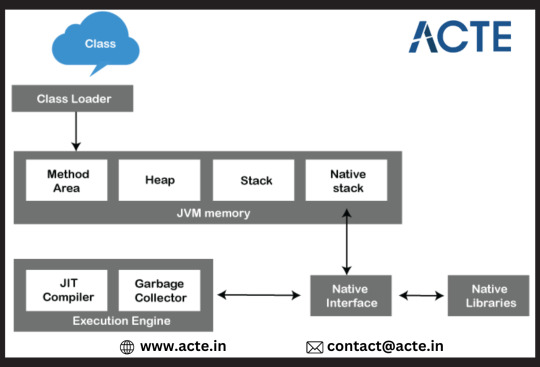
Class Loader:
· The Class Loader, an essential component of the JVM, dynamically loads classes into memory during runtime.
· It ensures that classes are loaded when required and maintains their uniqueness by loading each class only once.
· The process of class loading involves three steps: loading, linking, and initialization.
Method Area:
· The Method Area, a segment of the JVM’s memory, stores metadata for loaded classes.
· It houses critical information about class structures, method data, runtime constant pools, and static variables.
· Shared among all threads, the Method Area serves as a repository for per-class structures.
Heap:
· The Heap, a runtime data area within the JVM, is responsible for object allocation during Java application execution.
· Serving as a shared memory pool, the Heap facilitates dynamic memory allocation for Java objects.
· It comprises the young generation, old generation, and permanent generation, each serving specific memory management purposes.
Stack:
· The Stack, utilized by each thread of the JVM, stores method frames and related data.
· It holds local variables, method arguments, and partial results, crucial for method execution and memory management.
· With each method call, a new frame is pushed onto the stack, and upon method completion, the frame is popped off the stack.
Native Stack:
· The Native Stack is a memory area employed by the JVM to manage calls to native applications or libraries.
· It facilitates interactions with the underlying operating system and the execution of native code within the Java program.
· Essential for integrating Java programs with non-Java components and executing system-level operations.
Native Interface (JNI):
· JNI, a programming framework, enables Java code to interact with applications and libraries written in other languages, like C or C++.
· It fosters seamless integration between Java and native code, enabling bi-directional communication between Java applications and native code.
· Commonly utilized for enhancing performance and accessing system-level functionalities.
Native Libraries:
· Native Libraries, precompiled in languages such as C or C++, contain functions and procedures accessible by Java applications through the Java Native Interface (JNI).
· They enable Java programs to access system-specific features and perform tasks not directly supported by Java, including low-level system operations and hardware interactions.
Execution Engine:
· JIT Compiler
· Garbage Collector
JIT Compiler:
· The Just-In-Time (JIT) Compiler, an integral part of the runtime environment, enhances Java application performance by converting bytecodes into machine code during runtime.
· The JIT compiler, enabled by default, directly calls the compiled code of a method when it is compiled.
· This process optimizes performance by compiling bytecode into machine code “just in time” for execution.
Garbage Collector:
· The Garbage Collector in the JVM manages the removal of unused objects to optimize memory usage.
· It tracks and identifies objects in the JVM heap space that are no longer needed and clears them.
· The Garbage Collector operates in two main phases: Mark, where it identifies used memory, and Sweep, where it removes the identified unused objects.
The Java Virtual Machine (JVM) remains a fundamental pillar in the Java ecosystem, facilitating the smooth execution of Java applications across diverse platforms. Its pivotal role in translating platform-independent bytecode into machine-specific instructions has significantly propelled Java’s widespread adoption across various sectors, from enterprise software to web development and mobile applications.
We are honored to have accompanied you on this educational journey, and we extend our best wishes as you continue to explore the expansive realm of Java programming at ACTE Technologies. If you seek further knowledge in Java, we highly recommend reaching out to ACTE Technologies, where you can access certifications and job placement opportunities. Their experienced instructors can provide valuable guidance, whether through online or offline courses. Remember to take gradual steps and consider enrolling in a course if you feel inclined.
Embrace coding, embrace learning, and relish the promising path that awaits you in your dynamic career!
0 notes
Text
"Enhanced AI Programming with Java: Simplified Solutions and User Interaction"
Java is an excellent choice for creating artificial intelligence programs, known for its strong object-oriented architecture, reliability, and effective performance. It offers a wide array of frameworks and packages, such as Weka, JavaNNS, and JOONE, that simplify the implementation of AI projects.
Artificial Intelligence (AI) represents a specialized domain in computer science that focuses on building intelligent machines mirroring human behavior and responses. AI initiatives involve crafting computer systems with the ability to perceive and learn from their environment, engage in reasoning, make autonomous decisions, and demonstrate intelligent actions.

Artificial Intelligence Goals:
The fundamental aspirations of Artificial Intelligence include:
Simulating human intelligence
Solving knowledge-intensive tasks
Creating an intelligent link between perception and action
Building a machine capable of performing tasks that typically require human intelligence, such as theorem proving, chess playing, surgical planning, and driving in traffic.
Developing a system that exhibits intelligent behavior, autonomous learning, explanation, and guidance for users.
Components of Artificial Intelligence:
Artificial Intelligence extends beyond the realm of computer science, requiring a diverse array of contributing elements. To construct AI, one must comprehend the multifaceted nature of intelligence, which involves reasoning, learning, problem-solving, perception, and language comprehension.
Benefits of Programming Artificial Intelligence in Java:

Easy usage:
Java's user-friendly syntax and extensive documentation streamline the coding process, ensuring accessibility for developers of all levels of expertise.
Abundant learning resources and a supportive community contribute to a smooth learning curve, making Java a welcoming language for newcomers and experienced programmers alike.
Simplified work with large-scale projects:
Java's scalability and robust capabilities enable the handling of extensive data sets and complex computations, providing a stable foundation for managing large-scale projects efficiently.
Multithreading support enhances performance and resource management, particularly for projects dealing with substantial workloads and data processing demands.
Enhanced user interaction:
Java's support for GUI development through frameworks such as Swing and SWT facilitates the creation of intuitive and visually appealing interfaces, enhancing the overall user experience.
Event-driven architecture enables seamless interaction between users and applications, fostering the development of responsive interfaces tailored to diverse user preferences.
Anomaly detection:
Advanced data processing tools and statistical analysis libraries in Java empower the implementation of sophisticated anomaly detection algorithms, enabling the identification of irregular patterns within complex datasets.
Robust machine learning capabilities facilitate comprehensive analysis and interpretation of anomalies, aiding in the understanding of complex data patterns and trends.
Efficient time utilization:
Java's efficient memory management and optimized processing speed ensure the effective utilization of computing resources, allowing for high-performance execution of time-sensitive tasks.
Support for multithreading and parallel processing minimizes processing time, enhancing overall efficiency for time-critical operations.
Real-time engagement:
Java's architecture and toolset enable the creation of real-time engagement applications, fostering dynamic and interactive user experiences that can process and respond to data streams instantaneously.
Event-driven programming facilitates the development of responsive applications that can adapt to changing user inputs and environmental stimuli in real-time, promoting dynamic user engagement.
Seamless incorporation of Swing and SWT:
Java's integrated support for Swing and SWT libraries simplifies the development of user interfaces and interactive components, providing developers with versatile tools for creating visually appealing and responsive graphical interfaces.
Intuitive API and comprehensive documentation for Swing and SWT ensure seamless integration and utilization, enabling the design and implementation of complex GUI components with ease.
Streamlined visualization:
Java's comprehensive support for data visualization tools and libraries enables the creation of dynamic and interactive visualizations that effectively communicate complex data patterns and insights.
Advanced graphics and rendering capabilities offer developers powerful tools for designing visually appealing data representations that cater to diverse user preferences and data representation needs.
Effective data mining:
Java's extensive collection of data processing and analysis tools equips developers with the capability to extract valuable insights and patterns from complex and large-scale datasets.
Robust machine learning algorithms and statistical analysis libraries facilitate the implementation of sophisticated data mining techniques, enabling the extraction of actionable information from intricate data sets.
Simplified debugging:
Java's robust debugging tools and integrated development environments (IDEs) provide comprehensive capabilities for identifying and resolving software issues efficiently.
Support for breakpoints, watchpoints, and exception handling mechanisms enables developers to identify and address software bugs at various stages of the development process.
Java's error reporting and logging features provide insights into potential issues and areas for improvement, aiding in the systematic identification and resolution of software defects.
In summary, Java stands out as a dependable and efficient programming language for crafting Artificial Intelligence (AI) applications. Its rich collection of frameworks and libraries streamlines the implementation of AI algorithms, making it the preferred choice for AI development.
If you're looking to bolster your Java skills, consider exploring the comprehensive Java learning programs available through ACTE Technologies. Mastery of Java demands dedication, consistent practice, and continuous learning. ACTE Technologies offers inclusive Java learning programs, complete with certifications and job placement assistance, to help you attain proficiency in Java. Through persistent effort, you can build a strong command of Java and harness its capabilities to create a diverse portfolio of applications and projects.
0 notes
Text
Exploring Java's Statement Types: A Practical Overview
In the Java programming language, a statement acts as an executable directive that communicates to the compiler the intended operation to execute. It stands as a comprehensive instruction that the program should carry out, capable of encompassing multiple expressions. Unlike sentences in natural language, which convey complete ideas composed of various clauses, this differentiation aids in comprehending the practical significance of statements within the programming framework, drawing parallels to how sentences convey meaning and purpose in human communication. Grasping the fundamental nature of statements is essential in crafting efficient and meticulously organized Java programs.
Types of Statements in Java
Java statements can be broadly classified into the following categories
Expression Statements
Declaration Statements
Control Statements

Much like sentences convey meaningful concepts in human language, statements in Java serve as executable directives that the computer comprehends and carries out. Within the domain of Java programming, a statement stands as a self-contained code unit, executing specific actions or a defined set of actions. It encapsulates an entire notion or command that the Java compiler interprets and executes.
A profound understanding of the diverse categories of statements in Java is fundamental for crafting effective and functional code. These statements govern the course of program execution and facilitate the development of rational and streamlined Java applications. By classifying and employing various statement types, programmers can construct intricate and refined applications while maintaining precise control over the program's behavior and logic.
1. Expression Statements:
Expressions in Java serve as fundamental components that facilitate the creation of a new value, the assignment of values to variables, or the alteration of variable or program states. They are composed of combinations of values, variables, operators, and method calls.
There are three types of expressions in Java:
Expressions that produce a value:
These encompass mathematical or logical operations, generating specific values. For instance, (6+9), (9%2), or (pi*radius) + 2 exemplify such expressions.
Expressions that assign a value:
These expressions entail assigning a value to a variable. For instance, the expressions number = 90 or pi = 3.14 are indicative of this type.
Expressions that modify a variable or program state:
This category encompasses expressions that either increment or decrement a variable's value, such as count++, or perform operations without immediately producing an output, as demonstrated by int sum = a + b.
2. Declaration Statements:
In Java, declaration statements serve to establish variables and constants, specifying their respective data types and identifiers.
These statements allocate memory for the variables, defining their types and allowing the program to manage data.
Variables can be initialized during declaration using the assignment operator. Declaring multiple variables of the same data type in a single statement enhances the clarity and organization of the code.
Declaration statements form the bedrock for data management and storage within a Java program, enabling streamlined and effective programming procedures.
Variables store values utilized throughout the Java program.
3. Control Statements:
Control statements in Java determine the flow or sequence of execution of statements in a program. They can alter the program's execution based on certain conditions. There are the following types of control statements:
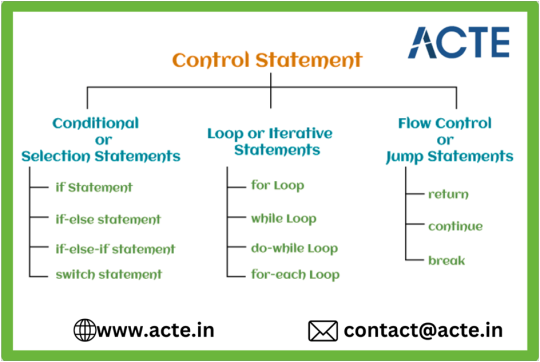
Conditional or Selection Statements:
These statements facilitate the execution of specific code blocks based on condition evaluation.
The 'if-else' statement executes a block of code if the condition is true and an alternative block if it's false.
The 'switch' statement enables the selection of a code block from multiple options.
Loop or Iterative Statements:
These statements allow the repetition of a code block as long as a given condition remains true.
The 'for' loop is utilized when the number of iterations is predetermined.
The 'while' loop is employed when the number of iterations isn't known in advance.
The 'do-while' loop is akin to the 'while' loop but verifies the condition after executing the code block.
The 'for-each' loop is ideal for iterating over elements in arrays and collections.
Flow Control or Jump Statements:
These statements regulate a program's flow by altering the sequence of execution.
The 'return' statement exits a method, 'continue' skips the current loop iteration, and 'break' exits a loop or switch statement.
Comprehending these statement types in Java is vital for creating efficient programs with precise control flow and logical operations.
In essence, Java's selection statement enables the execution of diverse code blocks contingent upon specific conditions. It encompasses the 'if', 'if-else', 'if-else-if', and 'switch' statements, empowering programmers to manage their program's flow in response to varying scenarios and inputs. Leveraging these constructs, developers can craft adaptable applications that dynamically adjust their behavior to meet diverse user requirements and varying circumstances. To expand your comprehension of Java, you may find it beneficial to explore the comprehensive Java learning programs available through ACTE Technologies. Attaining mastery in Java demands a combination of persistence, commitment, and continual practice. It's crucial to remain dedicated to refining your skills over time. The Java learning program at ACTE Technologies offers certifications and support for job placement, providing a structured path for enhancing your Java proficiency.
0 notes
Text
“Mastering Java: A Comprehensive Guide to Enhancing Your Coding Skills”
Java, known for its versatility and robust capabilities, serves as a fundamental programming language across various domains, ranging from web and mobile application development to enterprise solutions and software engineering. With the growing demand for skilled Java developers, the imperative to refine coding abilities has become paramount in the ever-evolving landscape of the tech industry.

Emphasizing the value of continuous learning, practical application, and collaborative engagement, this guide aims to equip you with the necessary tools and knowledge to thrive in the dynamic realm of Java programming. Whether you’re a beginner seeking to fortify your foundations or an experienced professional aspiring for mastery, the forthcoming sections will provide invaluable insights and guidance to elevate your Java coding proficiency. Join us on this journey to refine and elevate your Java coding skills, paving the way for a successful and gratifying career in the realm of software development.
1. Mastering the Fundamentals:
· Develop a solid understanding of fundamental Java concepts such as data types, variables, and object-oriented programming (OOP) principles.
· Familiarize yourself with different Java versions and their specific features to adapt to various programming environments.
· Explore the Spring Framework, a widely used Java framework for creating enterprise-level applications.
· Learn about Java design patterns to effectively implement scalable and efficient software solutions.
· Get acquainted with testing tools for unit testing to ensure the strength and dependability of your Java applications.
2. Coding, Coding, and More Coding:
· Regularly practice coding to cultivate a profound comprehension of Java syntax and semantics.
· Implement challenging concepts like multi-threading and exception handling to grasp their practical applications.
· Utilize coding as a means to identify and resolve design flaws, optimize program output, and enhance error-handling capabilities.
· Emphasize the significance of clear and concise coding practices to enhance the readability and maintainability of your codebase.
· Continuously challenge yourself with new coding tasks and projects to broaden your coding skills and problem-solving abilities.
3. Exploring Learning Resources:
· Utilize an array of books and online videos to access comprehensive and in-depth learning materials on Java programming.
· Engage with practical examples and case studies presented in these resources to understand the real-world applications of Java concepts.
· Actively participate in online communities and forums related to Java programming to seek guidance from experienced developers.
· Explore advanced topics and niche areas within Java programming through specialized books and video tutorials to expand your expertise.
· Use books and videos as valuable resources for troubleshooting coding issues and enhancing your overall programming skills.
4. Practicing Data Structures, Algorithms, and Design Challenges:
· Master essential data structures like arrays, linked lists, stacks, and queues to efficiently manage and manipulate data in Java.
· Develop a comprehensive understanding of essential algorithms like sorting, searching, and graph traversal to optimize program performance.
· Acquire proficiency in designing efficient and scalable software solutions by implementing appropriate design patterns and architectural principles.
· Solve various design-related problems and challenges to strengthen your problem-solving skills and enhance critical thinking abilities.
· Stay updated with the latest trends and advancements in data structures, algorithms, and software design to adapt to evolving industry standards.
5. Reading Code Effectively:
· Analyze code snippets from diverse sources like open-source projects, Java SDK, and proprietary software to gain insights into different coding styles and practices.
· Identify patterns and best practices in well-structured code to enhance your coding standards and improve code readability.
· Develop the ability to understand complex code logic and execution flow by studying and dissecting intricate code structures.
· Use code reading as a means to identify potential errors, bugs, and performance bottlenecks in existing Java codebases.

6. Understanding Unit Tests:
· Acknowledge the critical role of unit testing in software development and understand how to conduct comprehensive unit tests to ensure the quality and reliability of your code.
· Familiarize yourself with essential testing frameworks like JUnit and Mockito to effectively test and debug your Java applications.
7. Engaging in Code Reviews:
· Participate actively in code review sessions to receive valuable feedback and insights from peers or experienced developers.
· Use this feedback to identify and rectify coding errors and adopt best coding practices to enhance your skills.
8. Undertaking Real-World Projects:
· Gain valuable hands-on experience by working on real-world projects, whether personal projects or freelance assignments.
· Develop practical problem-solving skills by encountering and resolving challenges in live projects.
· Apply theoretical knowledge to practical scenarios and gain a deeper understanding of real-world coding situations.
9. Interacting with Fellow Programmers:
· Network and interact with other programmers to gain valuable learning opportunities.
· Broaden your perspectives through discussions, knowledge sharing, and participation in programming events to understand different coding approaches.
· Collaborate with peers to identify potential coding gaps and foster a supportive learning environment.
10. Cultivating Dedication:
· Dedicate yourself consistently to learning and practicing Java programming to achieve continuous improvement.
· Embrace a proactive approach to learning, stay motivated, and remain committed to your goal of becoming a proficient Java programmer.
Certainly, the path to becoming a proficient Java developer is an ongoing journey that demands patience, persistence, and an authentic passion for coding. By integrating the insights and practices outlined in this guide into your daily routine, you can cultivate a robust skill set and position yourself for success in the dynamic and ever-evolving realm of Java programming. Continuously explore, practice, and collaborate, and you’ll undoubtedly thrive as a skilled Java developer.
We are honored to have been a part of your learning journey, and we wish you every success as you continue to delve into the expansive world of Java programming with ACTE Technologies. If you’re looking to further your Java knowledge, I strongly recommend reaching out to ACTE Technologies, as they provide certifications and job placement opportunities. Their experienced instructors can offer valuable guidance to enhance your learning experience. These services are available both online and offline. Take things one step at a time, and consider enrolling in a course if you’re inclined.
0 notes
Text
Simplifying Java Programming Syntax: A Practical Handbook for Beginner Developers
Syntax refers to the specific format used for writing Java programs and the corresponding commands required to compile and execute them. Familiarity with the syntax is crucial for programmers and learners alike, as it determines the correct structure and composition of the code necessary for achieving desired outputs. Essentially, it serves as the language through which the compiler interprets and processes the instructions provided, playing a vital role in enabling effective communication between the programmer and the Java environment.

Java Syntax:
Java syntax serves as the foundation for writing Java code, encompassing the rules and conventions that dictate the structure and composition of the language. From basic components like data types and variables to more complex features such as control flow statements, object-oriented concepts, and exception handling, Java syntax forms the backbone of the language's functionality.
With its emphasis on readability, portability, and robust error-handling mechanisms, Java syntax enables the development of a wide array of applications across different platforms. By adhering to the principles of Java syntax, developers can create efficient and reliable programs that capitalize on the language's object-oriented capabilities and platform independence. let's immerse deeper into each of the topics in Java syntax to provide a more comprehensive understanding.
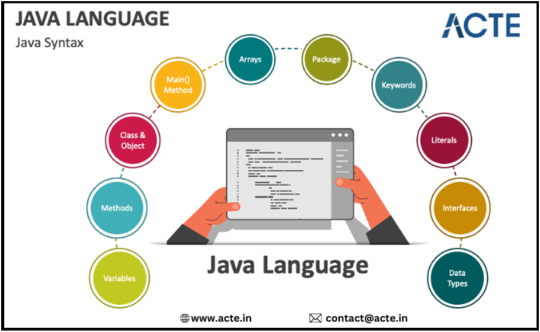
Variables:
Variables in Java are named storage locations used to hold data.
They must be declared with a specific data type before use.
Java supports various types of variables such as int, float, double, and String.
Variables can be initialized during their declaration or at a later stage.
They can also be classified as local, instance, or class variables.
The scope of a variable determines where it can be accessed within a program.
Methods:
Methods in Java are blocks of code that perform specific tasks.
They have a return type that specifies the type of value they return.
Java supports the concept of method overloading, enabling methods with the same name to have different parameter lists.
Methods are used to define the behavior of objects in a class.
They can be public, private, or protected, determining their access from other classes.
Method parameters act as variables within the method and are provided during method invocation.
Class & Object:
A class is a blueprint for creating objects that define their structure and behavior.
It encapsulates data for the object and provides methods to access or manipulate that data.
Objects are instances of classes, representing real-world entities.
They have states (defined by class variables) and behaviors (defined by methods).
Classes are the building blocks of Java programming and are used to create objects.
The class keyword is used to declare a class in Java, with fields and methods defined within the class.
Main Method():
The main method is the entry point of a Java program.
It must be declared as public, static, and void, following a specific syntax.
It acts as the starting point of the program's execution.
The main method can accept arguments from the command line, enabling interaction with the user.
It is the first method that the Java Virtual Machine (JVM) executes when running a Java program.
The main method can call other methods and instantiate objects within the program.
Arrays:
Arrays in Java are data structures used to store multiple values of the same data type.
They can be one-dimensional or multi-dimensional, depending on the requirements.
Array elements are accessed using an index, starting from 0 for the first element.
Java provides several methods to manipulate arrays, such as sorting and searching.
Arrays have a fixed size, which is defined during their initialization and cannot be changed afterward.
They are objects in Java and can be used to store primitive data types or objects.
Package:
A package in Java is a namespace that organizes a set of related classes and interfaces.
It is used to create a barrier and prevent naming conflicts in larger projects.
Packages provide a way to group related classes and interfaces together.
They enable access control and protect sensitive classes from unauthorized access.
Packages are imported using the import statement at the beginning of the Java file.
Java provides a standard library of packages that include commonly used utility classes and data structures.
Keywords:
Keywords in Java are reserved words that have predefined meanings and functionalities in the language.
They cannot be used as identifiers or variable names within the code.
Some common keywords include if, else, for, while, switch, and return.
Keywords play a crucial role in controlling the flow of the program and defining its structure.
Literals:
Literals are fixed values that can be assigned to variables directly in the code.
They include various types such as numeric literals, character literals, string literals, and boolean literals.
Numeric literals can be integers, decimals, binary, octal, or hexadecimal.
Character literals represent individual characters enclosed within single quotes.
String literals represent sequences of characters enclosed within double quotes.
Boolean literals represent the boolean values true and false.
Interfaces:
Interfaces in Java are abstract data types that define a set of abstract methods that must be implemented by any class that implements the interface.
They are used to achieve abstraction and support the concept of multiple inheritances in Java.
Interfaces can also contain constants and default and static methods.
They define a contract that a class must adhere to, ensuring the implementation of specific methods.
Data Types:
Data types in Java specify the type of data that can be stored in a variable.
They define the size and type of values that can be held and the operations that can be performed on them.
Java has two categories of data types: primitive data types and reference data types.
Primitive data types include int, double, char, boolean, and others.
Reference data types include classes, arrays, interfaces, and strings.
Understanding data types is essential for proper memory allocation and type safety in Java programming.
Final remarks, a solid understanding of Java syntax is fundamental for anyone venturing into Java programming. It serves as the foundation for writing efficient and error-free code, ensuring that instructions are properly communicated to the compiler. Through its specific rules and structure, Java syntax enables the creation of powerful and complex applications while providing a reliable framework for managing data, implementing algorithms, and defining program logic. By grasping the intricacies of Java syntax, programmers can harness the full potential of the language and build robust, scalable, and reliable software solutions to meet a diverse range of computational needs.
If you're looking to broaden your understanding of Java, you might consider exploring the comprehensive Java learning programs offered by ACTE Technologies. Successfully mastering Java requires a combination of perseverance, dedication, and consistent practice. It's essential to remain committed to honing your skills over time. Java learning program at ACTE Technologies provides certifications and job placement assistance. With sustained effort, you can achieve proficiency in Java and leverage its capabilities to build a diverse array of applications and projects.
0 notes
Text
"Java Data Structures: An In-Depth Exploration of Fundamental Concepts and Implementations"
Java has established itself as a widely adopted and influential programming language since its inception by Sun Microsystems in 1995. Its key feature of platform independence has enabled its deployment across diverse devices, contributing to its popularity among developers. Java's user-friendly syntax and extensive documentation have made it an accessible language for beginners, while its rich collection of libraries and frameworks cater to the demands of complex software development.
Data structures :
Data structures, they serve as essential formats for the organization, management, and manipulation of data in a structured and efficient manner.
This encompasses a broad spectrum of structures, both simple and intricate, designed to facilitate the systematic storage and retrieval of data for various applications.
By leveraging appropriate data structures, users can efficiently access data, ensuring its availability for processing and analysis, thereby optimizing workflow and enhancing the overall performance of applications.

Data Structures in Java:
Data structures in Java serve as the foundational framework for organizing and managing data within a computer's memory.
They encompass a diverse array of structures, including Arrays, Stacks, Queues, Linked lists, binary trees, hash tables, and more, which are crucial for facilitating efficient data manipulation and management within computer programs.
To operate on these data structures effectively, algorithms play a crucial role, enabling various operations such as inserting new data elements, deleting existing ones, searching for specific elements, and sorting data in a systematic and efficient manner.
By leveraging appropriate algorithms, these data structures can function optimally, ensuring streamlined data access and management within computer applications.
The importance of Data Structures in Java is evident in its significant role in coding interviews and assessment rounds.
A comprehensive understanding of data structures is fundamental in computer science, laying the groundwork for the development of efficient and high-performing software applications in Java.
Proficiency in Data Structures empowers developers to organize and manipulate data effectively, contributing to the streamlined and optimized functionality of software applications.
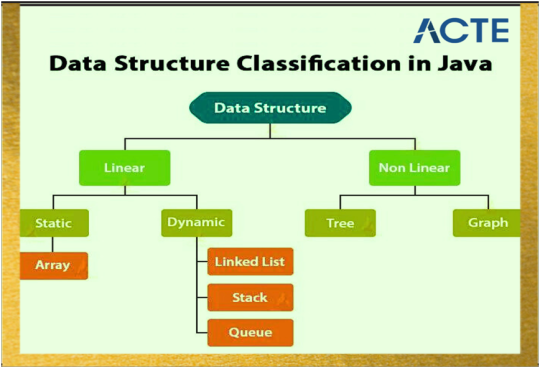
Data Structure Classification in Java:
Types of Data Structures in Java are broad of two types,
Linear Data Structures:
These data structures facilitate the sequential storage of data, allowing for the traversal of data elements in a linear order. Common examples of such linear data structures comprise arrays, linked lists, queues, and stacks.
Non-linear Data Structures: Non-linear data structures store data in a hierarchical or interconnected manner, facilitating intricate relationships between data elements. Instances of such non-linear structures encompass trees and graphs, enabling diverse advanced operations and representations due to the hierarchical or networked connections between data elements.
Linear Data Structures:
Arrays:
Arrays serve as a fundamental data structure, storing elements of a uniform data type in adjacent memory locations.
They facilitate constant-time access to elements through their index. However, their size remains fixed upon creation, posing challenges for dynamic resizing.
Java offers a range of utility methods and operations for managing arrays, including sorting, searching, and copying functionalities.
Linked Lists:
Linked lists are linear data structures where elements are stored as nodes, each containing a value and a reference to the next node in the sequence.
Unlike arrays, linked lists can dynamically adjust their size, allowing for convenient insertion and deletion of elements.
However, accessing specific positions in a linked list is less efficient than in arrays as it requires traversing the list from the beginning.
Stacks:
Stacks adhere to the Last-In-First-Out (LIFO) principle, meaning the last element added is the first one removed.
In Java, stacks can be implemented using the Stack class or the Deque interface.
They are commonly used for operations where the last-in-first-out order is crucial, such as managing function calls and recursive algorithms.
Queues:
Queues follow the First-In-First-Out (FIFO) principle, where the first element inserted is the first one removed.
In Java, queues can be created using various classes like LinkedList, PriorityQueue, or ArrayDeque.
They are applied in scenarios where operations need to be carried out based on the order of arrival, like task scheduling or resource management.
Non-linear Data Structures:
Trees:
Trees are hierarchical structures consisting of nodes connected by edges, without any cycles.
They have a root node from which all other nodes are accessible through different paths. Nodes can have zero or more child nodes, and those with no children are referred to as leaves.
Trees are efficient for searching and organizing, making them suitable for diverse applications, including databases and file systems.
Graphs:
Graphs are collections of nodes or vertices interconnected by edges. Unlike trees, graphs can have varied connections between nodes, allowing for complex relationships.
They find applications in diverse domains such as social networks, transportation networks, internet mapping, and recommendation systems.
Graphs enable the representation and analysis of relationships between different entities, facilitating tasks like pathfinding, network analysis, and optimization.
For those seeking to expand their proficiency in Java, ACTE Technologies serves as a valuable educational resource. They provide flexible learning choices, enabling students to study Java in online or traditional classroom settings. Their program is structured to offer certifications and job placement assistance, emphasizing a holistic approach to learning. Achieving mastery in Java demands consistent practice, dedication, and perseverance, all of which are fostered through the guidance and resources available at ACTE Technologies. Sustained commitment to skill development is essential for attaining expertise in the language and utilizing it for diverse application development endeavors.
0 notes
Text
"Exploring the Framework of Java Structure: A Comprehensive Overview"
The Java programming language has gained acclaim for its cross-platform capabilities and robust security features, establishing its dominance across diverse application domains over the last twenty years. Java's appeal stems from its powerful set of built-in functionalities. This article offers a detailed examination of the structural components of a Java program, addressing the following focal points:
• Documentation Section
• Package Statement
• Import Statement
• Interface Section
• Class Definition
• Main Method Class

Java programs are organized into various segments, including
Documentation Section:
Java comments are pivotal in improving code comprehensibility.
They furnish vital details about method usage and functionality, aiding programmers in understanding and debugging the code.
Java comments have the flexibility to appear anywhere within the code, without specific limitations.
During program execution, the Java compiler disregards these comments, emphasizing their role in enhancing the overall readability of the Java program.
Java supports three types of comments:
Single-line Comment: Indicated by "//", these comments serve to annotate code in a single line within Java.
Multi-line Comment: Employing "/" to commence and "/" to conclude, this comment type facilitates the creation of remarks spanning multiple lines.
Documentation Comment: Specifically for generating documentation for classes, methods, and fields, this comment style begins with "/**" and ends with "*/". It holds particular significance in producing documentation directly from the source code. Comprehending the distinct Java comment types and utilizing them effectively is essential for maintaining well-documented and easily understandable code.
Package Statement:
Java allows for the declaration of classes within a designated package, providing a systematic way of organizing code.
A Java program can have just one package statement, which should appear at the beginning of the code before any class or interface declarations. It's important to note that this statement is not mandatory.
In the given context, the package statement "student" indicates that all the classes and interfaces in the source file are grouped under the "student" package.
Adhering to the rule that only one package can be declared in a source file is crucial. Using packages aids in effectively organizing and managing related classes and interfaces within a Java program.
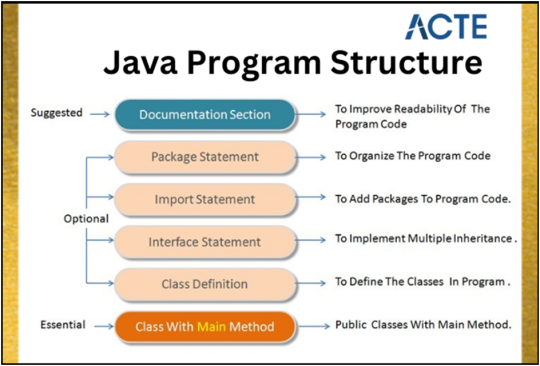
Import Statement:
Java encompasses numerous predefined classes stored within packages. To access classes stored in other packages, developers employ import statements.
Import statements are positioned after the package statement but before any class declarations in the program.
They enable the selective importation of specific classes or multiple classes from a package.
This streamlines the process of accessing functionalities from external packages, eliminating the need to explicitly reference the complete package path whenever a class from that package is utilized.
Interface Section:
The interface segment in Java is reserved for defining interfaces, critical for achieving multiple inheritance.
This optional section facilitates the definition of a contract for classes to implement. Although interfaces bear resemblances to classes, they differ in content.
While classes can contain variables, methods, constructors, and more, interfaces primarily consist of constant and method declarations.
It's essential to recognize that interfaces cannot be directly instantiated, meaning objects of an interface cannot be created. However, classes can implement one or multiple interfaces, inheriting their method declarations and constants.
Moreover, interfaces can be extended by other interfaces, allowing for the establishment of interface hierarchies. Implementing interfaces is pivotal in achieving polymorphism and ensuring the consistent implementation of specific methods across diverse classes.
Class Definition:
A Java program can encompass multiple class definitions, serving to define user-specific classes. Classes consist of variables and methods that manipulate the fields. Furthermore, every Java program is required to contain at least one class housing the main method.
Main Method Class: The main method marks the initiation point of a program's execution and is structured with distinct elements
Comments: Annotations included for enhanced code comprehension.
Braces: Enclosing brackets used to group commands within classes or methods.
Public Static Void Main: The declaration "public static void main" allows external access to the method, enabling access without object instantiation and non-return of any value.
String[] args: Represents an array of strings denoting input parameters.
System.out.println(): The "System.out.println()" statement is utilized to display output on the screen, with each Java statement concluded by a semicolon.
If you are seeking to enhance your understanding of Java, I highly suggest considering the Java course offered by ACTE Technologies. Their team of proficient instructors not only provides comprehensive learning opportunities but also offers diplomas and pathways to potential employment. These beneficial services are accessible both in-person and via online platforms provided by ACTE Technologies. Adopting a methodical learning approach and enrolling in one of their courses has the potential to significantly enrich your educational experience.
0 notes
Text
Comprehensive Guide to Java Operators: Understanding the Basics
Java Operators are of prime importance in Java. Our goal is to provide you with the necessary knowledge to start working with operators in Java. Without operators we wouldn’t be able to perform logical, arithmetic calculations in our programs. Thus having operators is an integral part of a programming language. In Java, operators are symbols used for performing various operations. These constructs enable the manipulation of operand values.
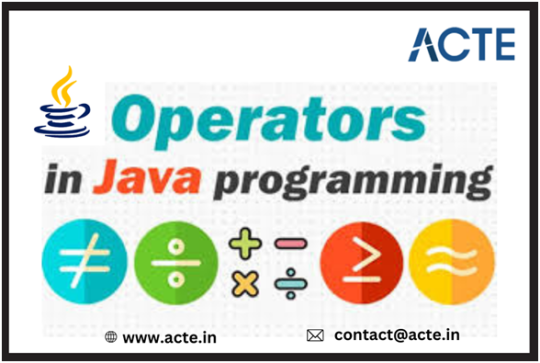
Operators are the symbols that perform the operation on values. These values are known as operands. In computer programming, an operator is a special symbol that is used to perform operations on the variables and values. The operators represent the operations (specific tasks) and the objects/variables of the operations are known as operands.
There As Many Types of Operators in Java As Follows:
Arithmetic Operators
Logical Operators
Unary Operators
Assignment Operators
Ternary Operators
Relational Operators
Bitwise Operators
Shift Operators
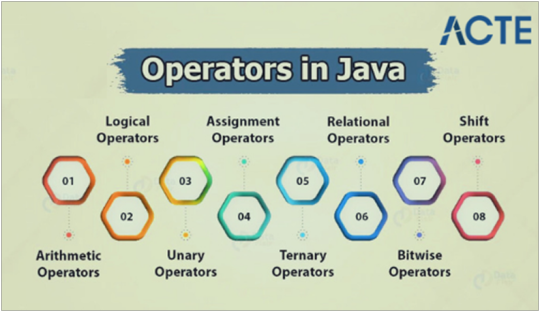
Arithmetic Operators:
Arithmetic operators in Java facilitate the execution of mathematical expressions, akin to their use in algebra. Java offers operators for five fundamental arithmetic computations: addition, subtraction, multiplication, division, and calculating the remainder. These operations are denoted by the symbols +, -, *, /, and %, respectively. Each of these operators functions as a binary operator, necessitating two values (operands) to carry out the calculations.
Addition (+):
The addition operator (+) in arithmetic performs the task of summing the values of its operands, resulting in the addition of the two values. The operands involved can be of various types, including integer (int, short, byte, long, double) or floating-point (float and double) types.
Subtraction (-):The subtraction operator (-) in Java subtracts the second operand from the first. This operator can work with operands of integer or float types.
Multiplication (*):In Java, the multiplication operator (*) is used to multiply the values of its operands. These operands can be of either integer or float types.
Division (/):In Java, the division operator (/) is used to divide the first operand by the second. The operands may be of either integer or float types.
Modulus (%):The modulus operator (%) in Java computes the remainder of the division of its first operand by the second operand. It essentially finds the modulus of the first operand with respect to the second operand.
Logical Operators in Java
Logical operators, also referred to as conditional operators, are essential for evaluating boolean expressions in complex decision-making scenarios. They generate a boolean value (true or false) as output.
In Java, there are three types of logical or conditional operators: && (Logical-AND), || (Logical-OR), and ! (Logical NOT). Among these, && (Logical-AND) and || (Logical-OR) are binary logical operators that operate on two operands or expressions, while ! (Logical NOT) is a unary logical operator that operates on a single operand or expression. Let's explore into each of them in detail:
The Logical AND Operator (&&):
It combines two expressions (operands) into one expression, evaluating to true only if both of its expressions (operands) are true.
The Logical OR Operator (||):
This operator also combines two expressions (operands) into one expression, resulting in a true evaluation if either of its expressions (operands) evaluates to true.
The Logical NOT Operator (!):
It is a unary operator that works on a single operand or expression, negating or reversing the truth value of its operand.
Unary Operators:
Unary operators in Java work on a single operand and can be classified into two types:
Unary plus (+):
This operator signifies the identity operation, leaving the operand value unchanged. For instance, if "number1" is 5, then "+number1" remains 5.
Unary minus (-):
This operator changes the value of the operand to its negative. If "number1" is 5, then "-number1" becomes -5.
Increment/Decrement operators (++/--):
Java includes the increment (++) and decrement (--) operators, which increase or decrease the value of the operand by 1. These operators can be used in two forms: pre-increment and post-increment, as well as pre-decrement and post-decrement.
Assignment Operator (=):
In Java, the assignment operator (=) is employed for assigning a value to a variable.
It adheres to the principle of right-to-left associativity, signifying that the value on the right-hand side of the operator is assigned to the variable on the left-hand side.
Thus, it is crucial to declare the value on the right-hand side before using it or ensure that it remains a constant. This operator serves a fundamental purpose in initializing and updating variables within Java programs.
Ternary Operator
The Java ternary operator is designed to streamline and simulate the if-else statement. It consists of a condition followed by a question mark (?).
The pattern involves two expressions separated by a colon (:).
When the condition evaluates to true, the first expression is executed; otherwise, the second expression is executed.
6. Relational Operators in Java
· Relational operators in Java facilitate the comparison of numbers and characters, helping to establish the relationship between operands.
· These operators assess the relation among the operands and yield results in the boolean data type.
· They play a crucial role in looping and conditional if-else statements. It is worth noting, however, that relational operators do not function on strings.
Certainly, Here Are the Six Relational Operators in Java Along With Their Corresponding Functionalities:
Equal to (==) Operator: Returns true if the left-hand side is equal to the right-hand side; otherwise, it returns false.
Not Equal to (!=) Operator: Returns true if the left-hand side is not equal to the right-hand side; otherwise, it returns false.
Less Than (<) Operator: Returns true if the left-hand side is less than the right-hand side; otherwise, it returns false.
Less Than or Equal to (<=) Operator: Returns true if the left-hand side is less than or equal to the right-hand side; otherwise, it returns false.
Greater Than (>) Operator: Returns true if the left-hand side is greater than the right-hand side; otherwise, it returns false.
Greater Than or Equal to (>=) Operator: Returns true if the left-hand side is greater than or equal to the right-hand side; otherwise, it returns false.
Bitwise Operators in Java :
Bitwise operators in Java are used to manipulate the individual bits of a number. These operators work with integer types, including byte, short, int, and long. Java provides four bitwise operators:
Bitwise AND Operator (&): Performs a Bitwise AND operation on each corresponding pair of bits of its operands, producing a 1 only if both corresponding bits are 1.
Bitwise OR Operator (|): Returns the Bitwise OR operation for each corresponding pair of bits of its operands, resulting in a 1 if at least one of the bits is 1.
Bitwise XOR Operator (^): Produces a 1 if the two bits of the operands are different; otherwise, the result is 0.
Bitwise Complement Operator (~): Inverts the value of each bit of the operand, turning 1s to 0s and 0s to 1s.
You can use these operators to perform various bitwise operations on numbers. The provided code snippet demonstrates the application of these operators in Java.
8. Shift Operators:
Shift operators in Java are used to perform bit manipulation on operands by shifting the bits of the first operand to the right or left. There are three shift operators available in Java:
Signed Left Shift Operator (<<): This operator shifts the bits of a number or operand to the left and fills the vacated bits on the right with 0. It has a similar effect to multiplying the number with a power of two.
Signed Right Shift Operator (>>): The signed right shift operator shifts the bits of the number to the right. The leftmost vacated bits in this operation depend on the sign of the leftmost bit, or the most significant bit (MSB) of the operand. It has an effect similar to dividing the number by a power of two.
Unsigned Right Shift Operator (>>>): The unsigned right shift operator also shifts the bits of the number to the right. In this operation, the leftmost vacated bits are always set to 0, regardless of the sign of the leftmost bit or the most significant bit (MSB).
It's important to note that in Java, the signed right shift operation fills the vacated bits with a sign bit, while the left shift and the unsigned right shift operation fill the vacated bits with zeroes. These operators allow for various bitwise operations and are useful in scenarios where direct manipulation of bits is required.
In Java, apart from the fundamental arithmetic, logical, bitwise, and shift operators, there are several other operators that serve diverse purposes within the language:
• The Dot . Operator:
The dot operator (.) is utilized to access instance members of an object or class members of a class.
• The () Operator:
The () operator is used for declaring or calling methods or functions. Arguments for a method can be listed between parentheses, and an empty argument list can be specified using () with nothing between them.
• The instance Of Operator:
The instanceof operator is employed for type checking. It verifies whether its first operand is an instance of its second operand, testing whether an object is an instance of a class, a subclass, or an interface.
Having completed my Java training at ACTE Technologies, I highly recommend their program to individuals seeking to enhance their Java skills. With experienced instructors proficient in Java training, they provides a variety of flexible learning options, catering to both online and in-person preferences. In ACTE Technologies, Java program includes certification opportunities and assistance in securing job placements.
0 notes
Text
"From Oak to Java: Tracing the Evolution of a Revolutionary Programming Language"
Java's Origins:
Java, an Object-Oriented programming language, was conceived by James Gosling in the early 1990s, with the goal of creating a language for digital devices like set-top boxes and televisions. Initially considering C++ but facing memory constraints, Gosling shifted to creating a new platform, initially named "Greentalk," with the file extension .gt, which later transformed into "OAK."
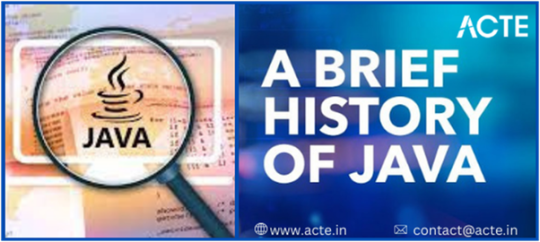
Choosing "Oak":
The name "Oak" was inspired by an oak tree near Gosling's office, symbolizing strength and also being the national tree of several countries. However, due to trademark conflicts with Oak Technologies, the project was eventually renamed "JAVA" after an extensive brainstorming session, which included several other options like DNA, SILK, and RUBY. The unique and memorable nature of "Java," derived from a type of coffee bean, led to its selection, a name inspired by a coffee break near Gosling's office.
Java's Journey:
Built on principles of robustness, portability, platform independence, high performance, and multithreading, Java was recognized as one of the Ten Best Products of 1995 by TIME MAGAZINE. Presently, Java finds application in various domains such as internet programming, mobile devices, games, and e-business solutions.
Java's Evolution:
Over the years, Java has undergone significant transformations since JDK 1.0, with numerous additions and extensions to the standard library, expanding from a few hundred classes in JDK 1.0 to over three thousand in J2SE 5.
Highlighting Their Key Developments and Enhancements:
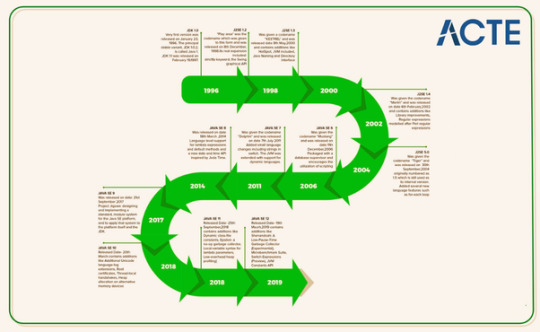
JDK Beta (1995): This was an early stage in Java's development, representing the initial testing and experimentation phase.
JDK 1.0 (January 1996): The Very first version was released on January 23, 1996. The principal stable variant, JDK 1.0.2, is called Java 1.
JDK 1.1 (February 1997):
It was released on February 19, 1997. There were many additions in JDK 1.1 as compared to version 1.0 such as
· A broad retooling of the AWT occasion show
· Inner classes added to the language
· JavaBeans
· JDBC
· RMI
J2SE 1.2 (December 1998):
“Play area” was the codename which was given to this form and was released on 8th December 1998. Its real expansion included: strictfp keyword
· the Swing graphical API was coordinated into the centre classes
· Sun’s JVM was outfitted with a JIT compiler out of the blue
· Java module
· Java IDL, an IDL usage for CORBA interoperability
· Collections system
J2SE 1.3 (May 2000):
Codename- “KESTREL” Release Date- 8th May 2000 Additions:
· HotSpot JVM included
· Java Naming and Directory Interface
· JPDA
· JavaSound
· Synthetic proxy classes
J2SE 1.4 (February 2002):
Codename- “Merlin” Release Date- 6th February 2002 Additions: Library improvements
· Regular expressions modelled after Perl regular expressions
· The image I/O API for reading and writing images in formats like JPEG and PNG
· Integrated XML parser and XSLT processor (JAXP) (specified in JSR 5 and JSR 63)
· Preferences API (java.util.prefs)
· Public Support and security updates for this version ended in October 2008.
J2SE 5.0 (September 2004):
Codename- “Tiger” Release Date- “30th September 2004”
Originally numbered as 1.5 which is still used as its internal version. Added several new language features such as
· for-each loop
· Generics
· Autoboxing
· Var-args
Java SE 6 (December 2006):
Codename- “Mustang” Released Date- 11th December 2006 Packaged with a database supervisor and encourages the utilization of scripting languages with the JVM. Replaced the name J2SE with java SE and dropped the .0 from the version number. Additions:
· Upgrade of JAXB to version 2.0: Including integration of a StAX parser.
· Support for pluggable annotations (JSR 269).
· JDBC 4.0 support (JSR 221)
Java SE 7 (July 2011):
Codename- “Dolphin” Release Date- 7th July 2011 Added small language changes including strings in the switch. The JVM was extended with support for dynamic languages. Additions:
· Compressed 64-bit pointers.
· Binary Integer Literals.
· Upstream updates to XML and Unicode.
Java SE 8 (March 2014): Released with the codename "Spider," this version introduced language level support for lambda expressions and default methods. It also included a new date and time API inspired by Joda Time.
Java SE 9 (September 2017): This version introduced Project Jigsaw, which aimed to modularize the Java SE platform. It implemented a standard module system for the Java SE platform and the JDK.
Java SE 10 (March 2018):
Released Date- 20th March Addition:
· Additional Unicode language-tag extensions
· Root certificates
· Thread-local handshakes
· Heap allocation on alternative memory devices
· Remove the native-header generation tool – javah.
· Consolidate the JDK forest into a single repository.
Java SE 11 (September 2018):
Released Date- 25th September, 2018 Additions-
· Dynamic class-file constants
· Epsilon: a no-op garbage collector
· The local-variable syntax for lambda parameters
· Low-overhead heap profiling
· HTTP client (standard)
· Transport Layer Security (TLS) 1.3
· Flight recorder
Java SE 12 (March 2019):
Released Date- 19th March 2019 Additions-
· Shenandoah: A Low-Pause-Time Garbage Collector (Experimental)
· Microbenchmark Suite
· Switch Expressions (Preview)
· JVM Constants API
· One AArch64 Port, Not Two
· Default CDS Archives
In conclusion, Java's journey from its early inception as "Oak" to its eventual renaming as "Java" represents a fascinating tale of innovation and adaptability. Java's evolution, marked by its recognition as one of the Ten Best Products of 1995 by TIME MAGAZINE and its widespread adoption across diverse industries, is a testament to its enduring significance and impact on the modern technological landscape. As Java continues to evolve with each version, it remains a cornerstone of the programming world, embodying the principles of robustness, flexibility, and adaptability that have propelled it to its current prominence.
For individuals aiming to enhance their Java expertise, exploring the offerings of ACTE Technologies is highly recommended. With proficient instructors well-versed in Java instruction, ACTE Technologies provides a range of flexible learning options, accommodating both online and in-person preferences. Java program at ACTE Technologies includes certification options and support in finding job placements.
1 note
·
View note
Text
Understanding Different Kinds of Java: Going Deeper into How Computers Work
Java technology serves as both a programming language and a platform. It encompasses four distinct editions: Java Standard Edition (Java SE), Java Enterprise Edition (Java EE), Java Micro Edition (Java ME), and JavaFX. These editions are designed to cater to various application development needs and come with their own set of Application Programming Interfaces (APIs) and Java Virtual Machines (JVMs) to facilitate program execution.
The Four Types of Java:
Java Standard Edition (Java SE),
Java Enterprise Edition (Java EE), and
Java Micro Edition (Java ME).
JavaFX
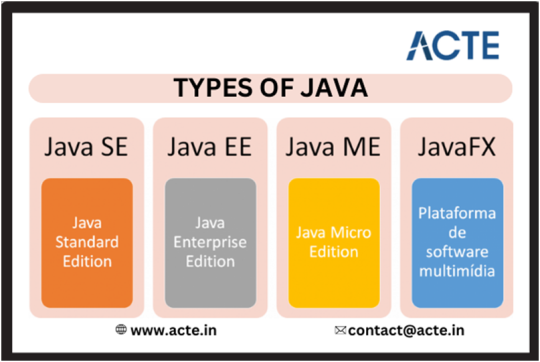
Java Standard Edition (Java SE):
Java SE provides fundamental programming features, covering everything from basic data types and objects to advanced functionalities like graphical user interface development, database manipulation, and networking.
The Java SE Platform Includes:
JVM (Java Virtual Machine),
JDK (Java Development Kit),
JRE (Java Run-time Environment), and
Various class libraries.
These components of Java SE are frequently used in Java technology applications in extension to the main APIs.
Java Enterprise Edition (Java EE):
Java EE builds upon Java SE by adding a set of standards and specifications tailored for commercial applications.
It encompasses over 40 specifications to help developers create applications that use web services, handle transactional interactions, and manage data transformation from object-relational models to entity-relationship models.
The Most Used Features of Java EE Are:
Java Server Pages (JSP): It is a server-side programming language that makes possible to construct dynamic, device-independent ways to build web-based applications.
Java Server Faces (JSF): The JSF API offers elements such as inputText, commandButtons, and others and assists in managing their states. Additionally, it offers data translation, server-side validation, etc.
Java Persistence API (JPA): Java developers get access to an object/relational mapping mechanism through the Java Persistence API, to manage relational data in Java applications.
Enterprise Java Beans (EJB): It is one of the many Java APIs used for the development of corporate applications. EJB is a server-side software component that defines an application's business logic.
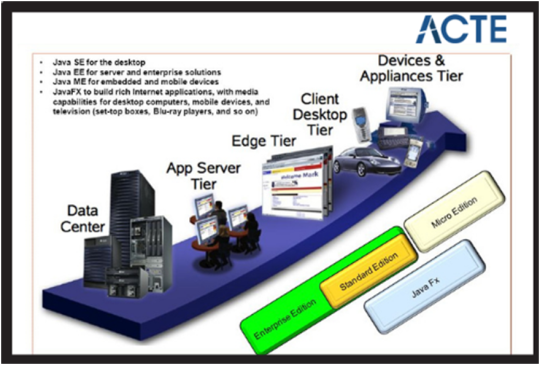
Java Micro Edition (Java ME):
Java ME is designed for mobile and embedded device applications.
While it may not be as popular as Java SE and Java EE, it has gained relevance in the context of Internet of Things (IoT) devices.
Java ME provides an API and a lightweight virtual machine for running Java applications on compact devices.
Some Examples of Java ME Applications Are Given Below:
Calculator for Mobile which demonstrates the functionality of multi-threading.
GPIO (General Purpose Input Output) applications.
Location APIs, etc.
JavaFX:
JavaFX is a platform for building modern, hardware-accelerated graphics and media-rich applications.
It offers a simple scripting language (JavaFX Script) for developing online, GUI, and desktop applications.
JavaFX serves as a replacement for Swing as the default GUI library and has applications in various fields, including television media, finance, space technology, and medicine.
Some Applications of JavaFX Are Given Below:
NEOS – New Eurovision Operations System used in the area of Television media.
Quote Monitor application is used in the field of finance.
GEONS Ground System Software (GGSS) Nasa is used in the field of space technology.
FORUM Carl Zeiss Meditec AG is used in the field of medicines.
Each edition serves unique purposes within the Java ecosystem, catering to a broad range of application development needs.
For those looking to expand their Java knowledge, ACTE Technologies is worth exploring. Their instructors are highly skilled and proficient in teaching Java. Whether you prefer online or in-person learning, they offer flexibility in your choice of learning environment. Java program at ACTE Technologies includes certification options and support in finding job placements. In essence, becoming a Java expert necessitates persistence, commitment, and consistent practice.
0 notes